💡 Ahrefs is excellent, but it isn’t the only way to research keywords, check backlinks, audit your site, or spy on competitors.
Depending on your goals and budget, a lighter, cheaper, or more focused tool might fit better right now—especially if you follow a proven SaaS keyword research guide to validate topics quickly. Maybe you want easier reports for clients, deeper technical crawling (start by shortlisting the best site audit tools), or stronger competitor/PPC insights without the premium price tag (see when to balance SEO with ads in blog vs paid ads for SaaS growth). This guide keeps the choices simple and action-oriented so you can decide fast and get back to shipping work.
What you’ll find inside:
- Quick recommendations by budget and use-case.
- A 15-second comparison table for fast scanning.
- FAQs plus a one-minute summary so you can make the call immediately.
▶️ At The Rank Masters, we run these tools across real campaigns “local services, B2B, ecommerce, and content sites”. The picks below reflect what consistently helps teams hit targets: clearer research, cleaner audits, smarter priorities, and results you can measure. If you’re ready to turn insights into a pipeline with hands-on help, talk to a specialist team (SaaS SEO agency). Use this guide to match the right tool to your next 90 days, then upgrade or mix in a specialist as your needs grow.
Table of Contents
Top Ahrefs Alternatives: The Best SEO Tools to Match Your Goals and Budget
Below, each tool follows the same simple structure so you can skim fast: Why pick it, Where it shines vs Ahrefs, Keep in mind, Best for, Pricing snapshot, Try if you need.
| Tool | Best For | Standout Features | Learning Curve |
|---|---|---|---|
| Semrush | All-around suite | SEO + PPC research, competitor intel, content tools | Moderate |
| SE Ranking | Value suite | Rank tracking, site audit, reports | Easy–Moderate |
| Moz Pro | Beginners | On-page suggestions, clean UI | Easy |
| Mangools (KWFinder) | Keyword ideas | Intuitive keyword research, SERP overview | Easy |
| Majestic | Backlinks | Trust Flow, Topical Flow, deep link analysis | Moderate |
| Ubersuggest | Low-cost start | Basic keywords, audits, rank tracking | Easy |
| SpyFu | Competitor/PPC | Historical ads + keywords, overlap insights | Easy |
| Serpstat | Budget all-in-one | Broad coverage, team-friendly | Moderate |
| Screaming Frog | Technical audits | Powerful desktop crawler, exports | Moderate |
| GSC + GA + Planner | Zero-budget | First-party data, essentials | Easy–Moderate |
1. Semrush — Best All-Around Replacement
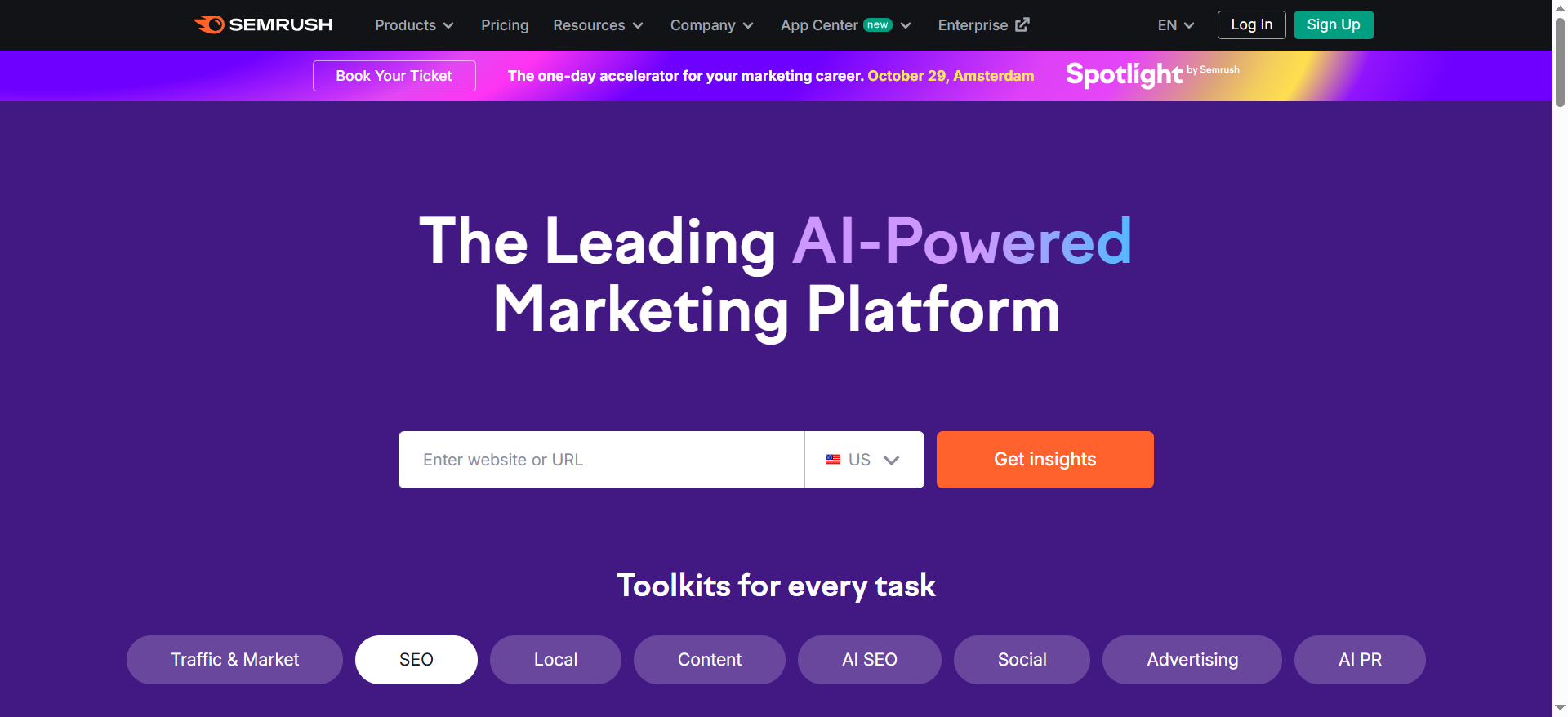
Wide SEO coverage plus PPC/ads intel and content tools. Great for competitor recon and campaign planning under one roof. It bundles keyword ideas, backlink checks, position tracking, and content briefs, so you can research, plan, and report from the same place. If you need both SEO and paid search visibility, it’s a strong “one login” setup.
▶️ Where it shines vs Ahrefs: Strong paid search insights, competitive research depth, and content marketing add-ons. You’ll see rivals’ keywords, ads, and landing pages side by side, which makes it easier to spot gaps and campaign angles.
Keep in mind: It’s powerful, which can feel dense at first. Start with a few core reports before exploring everything.
Best for: Agencies and in-house teams needing SEO + PPC visibility.Try if you need: One suite for SEO, competitor analysis, and ad insights.
First steps: Run Domain Overview on your site and top 3 competitors, use Keyword Magic Tool to save 20 long-tails, then launch a Site Audit and fix the top errors it flags.
2. SE Ranking — Best Balance of Features & Price
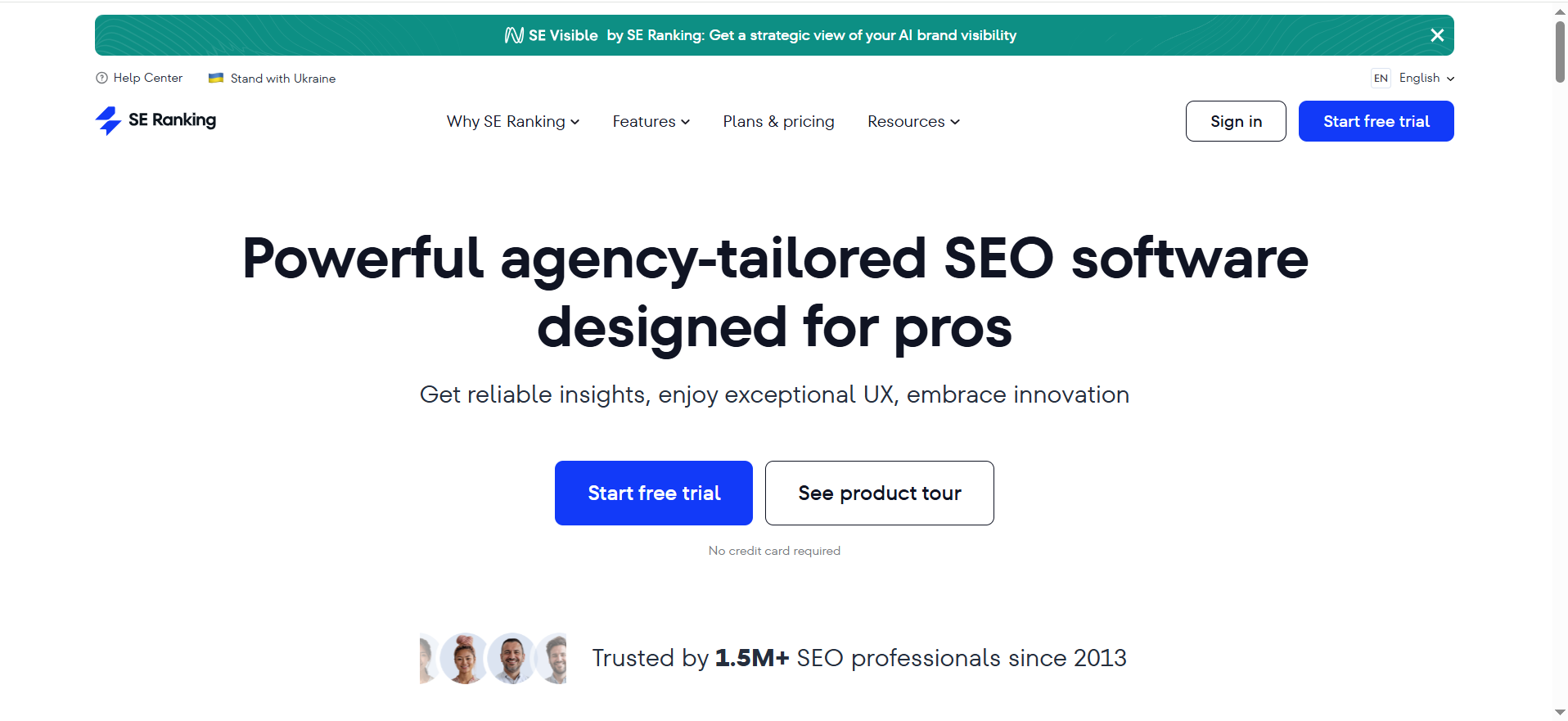
Rank tracking is reliable, site audits are thorough, and reporting is client-friendly—without the top-tier price. It’s easy to set up projects, track growth weekly, and share clean, branded reports with stakeholders.
▶️ Where it shines vs Ahrefs: Pricing flexibility and simple dashboards for teams. The interface focuses on the essentials, so you can move faster with less training.
Keep in mind: Backlink index isn’t as deep as the “big two,” but solid for most use cases. Pair it with GSC or a link specialist if backlinks are your main game.
Best for: SMBs, growing agencies, budget-conscious teams.Try if you need: Clear reporting and dependable rank tracking.
First steps: Add your target keywords to Rank Tracker, run a Website Audit, and generate a Marketing Plan report to create a simple, shareable to-do list.
3. Moz Pro — Easiest Onboarding for Beginners
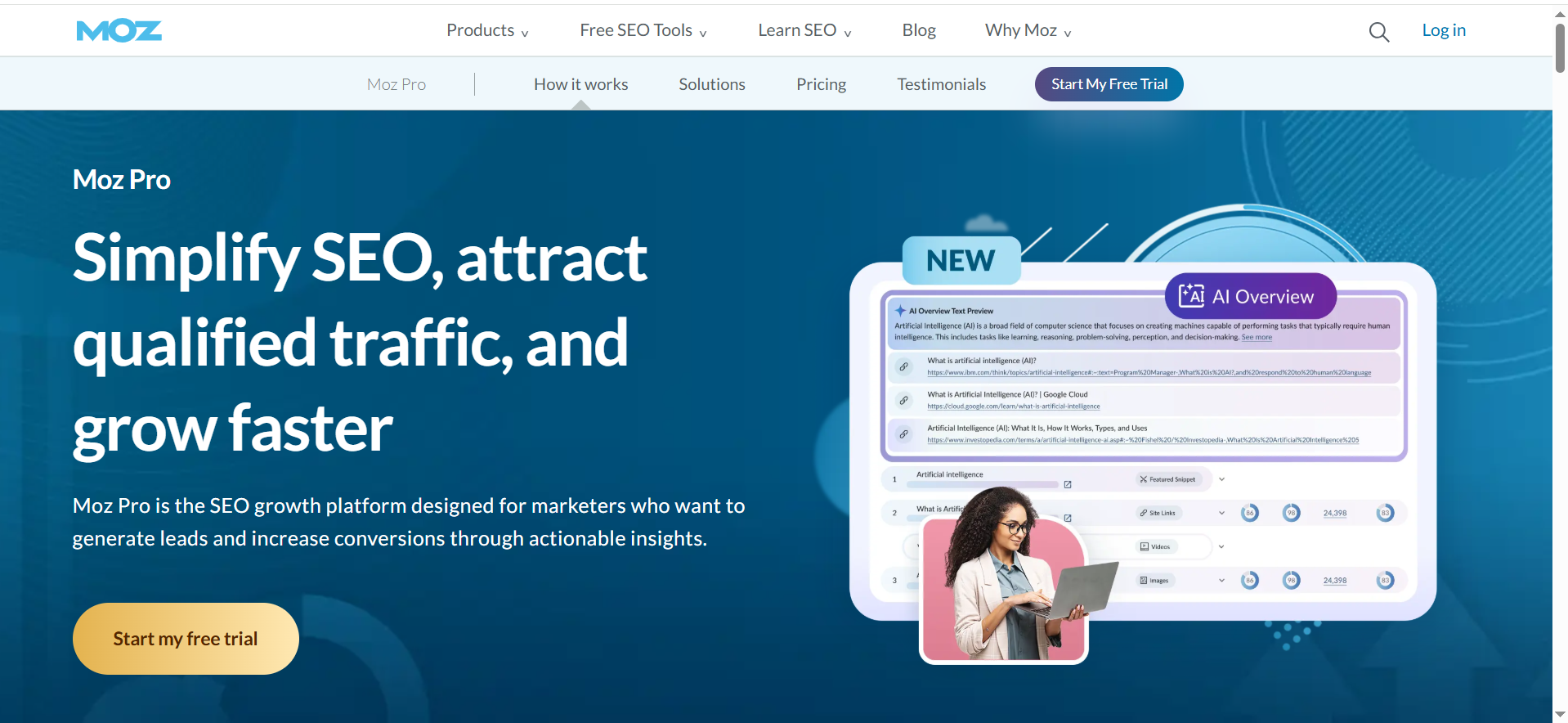
Clean UI, on-page recommendations, and supportive learning resources help you move fast without getting overwhelmed. You’ll get practical prompts (titles, headings, internal links) that make first wins straightforward.
▶️ Where it shines vs Ahrefs: Smoother learning curve and actionable page-level guidance. Great for teams who want “do this next” suggestions rather than heavy data digging.
Keep in mind: Data depth and power users’ needs may outgrow it. As you mature, you might add a crawler or competitor tool.Best for: Bloggers and small teams starting SEO.
Try if you need: Friendly UX and straightforward best-practice prompts.
First steps: Run Site Crawl, open the Page Optimization suggestions for 5 key pages, and make one fix per page (titles, H1s, internal links).
4. Mangools (KWFinder Suite) — Best for Keyword Discovery
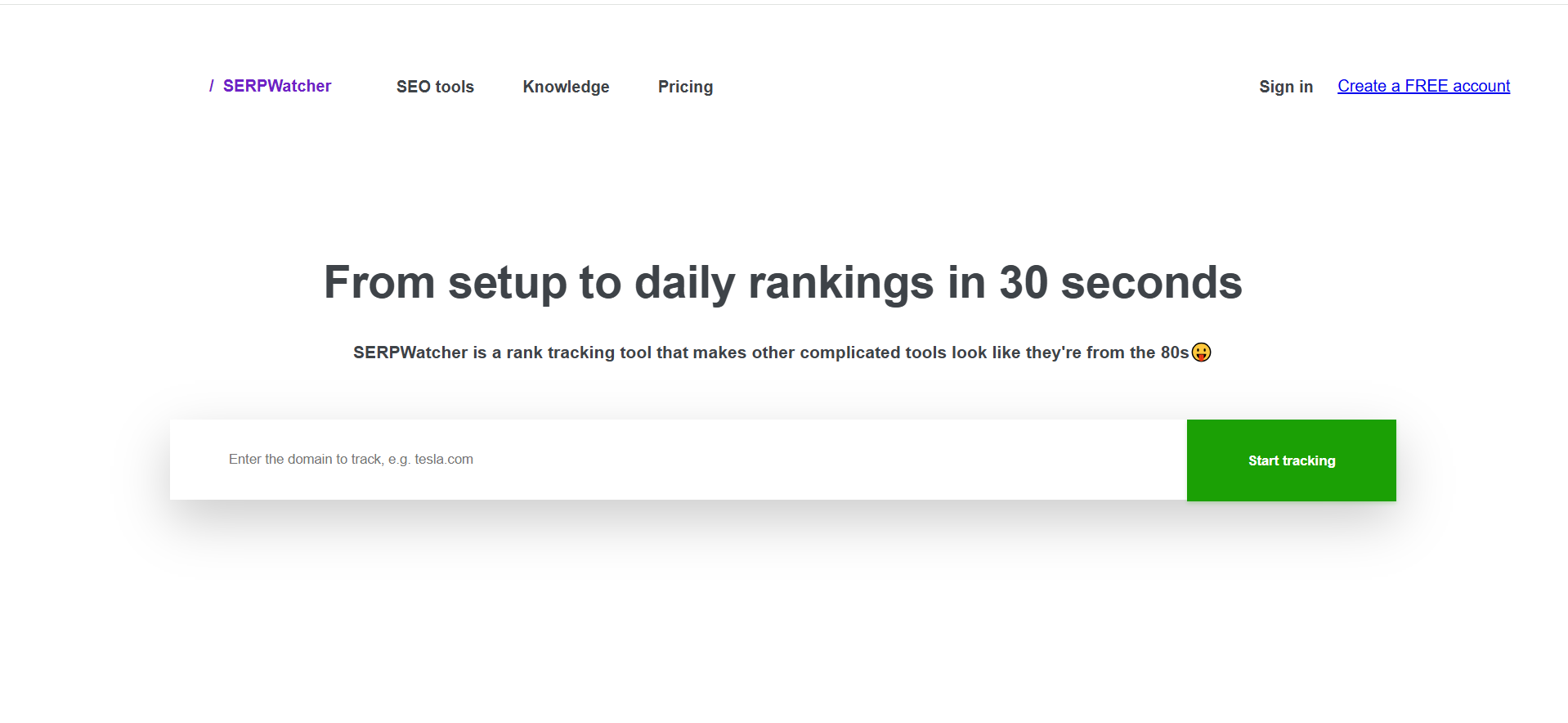
KWFinder is one of the most intuitive keyword tools—great for discovering long-tails and mapping content quickly. The SERP view is simple, so you can judge difficulty and intent at a glance.
▶️ Where it shines vs Ahrefs: Speed to insight for keywords and SERP snapshots. It’s ideal when you need topic ideas for the next few posts without getting lost in settings.
Keep in mind: Not built for deep technical SEO or advanced link analysis. Use it as a content planning helper, not your entire stack.
Best for: Content-led teams and solo creators.
Try if you need: Fast keyword ideas without complexity.
First steps: Pop in a seed term, sort by Low KD, save 10–15 topics, then check SERPChecker to note what you must beat (word count, headings, intent).
5. Majestic — Best for Deep Backlink Analysis
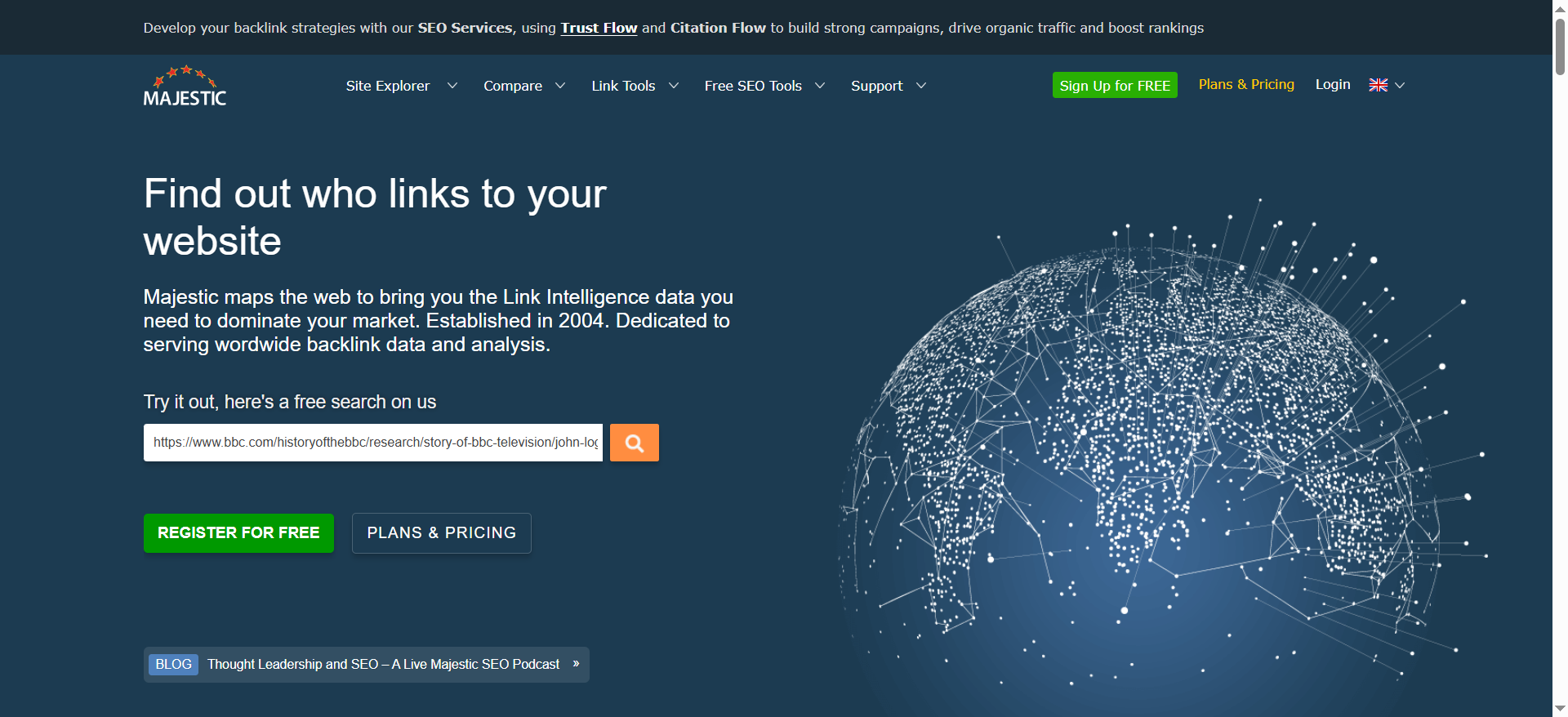
Link-focused platform with metrics like Trust Flow and Topical Flow for evaluating link quality and relevance. It helps you judge whether a site linking to you (or a prospect) is credible and contextually relevant.
▶️ Where it shines vs Ahrefs: Specialized link graph analysis; useful for outreach prioritization and competitor link profiling. You can quickly group prospects by topical category to keep outreach focused.
Keep in mind: Limited keyword/content tooling—pair with other tools. It’s a specialist, not an all-in-one.
Best for: Link builders and analysts.
Try if you need: Serious backlink forensics and topical authority checks.
First steps: Compare your domain vs two competitors in Compare Tool, sort referring domains by Topical Trust Flow, and build an outreach list from relevant topics.
6. Ubersuggest — Best Low-Cost Starter
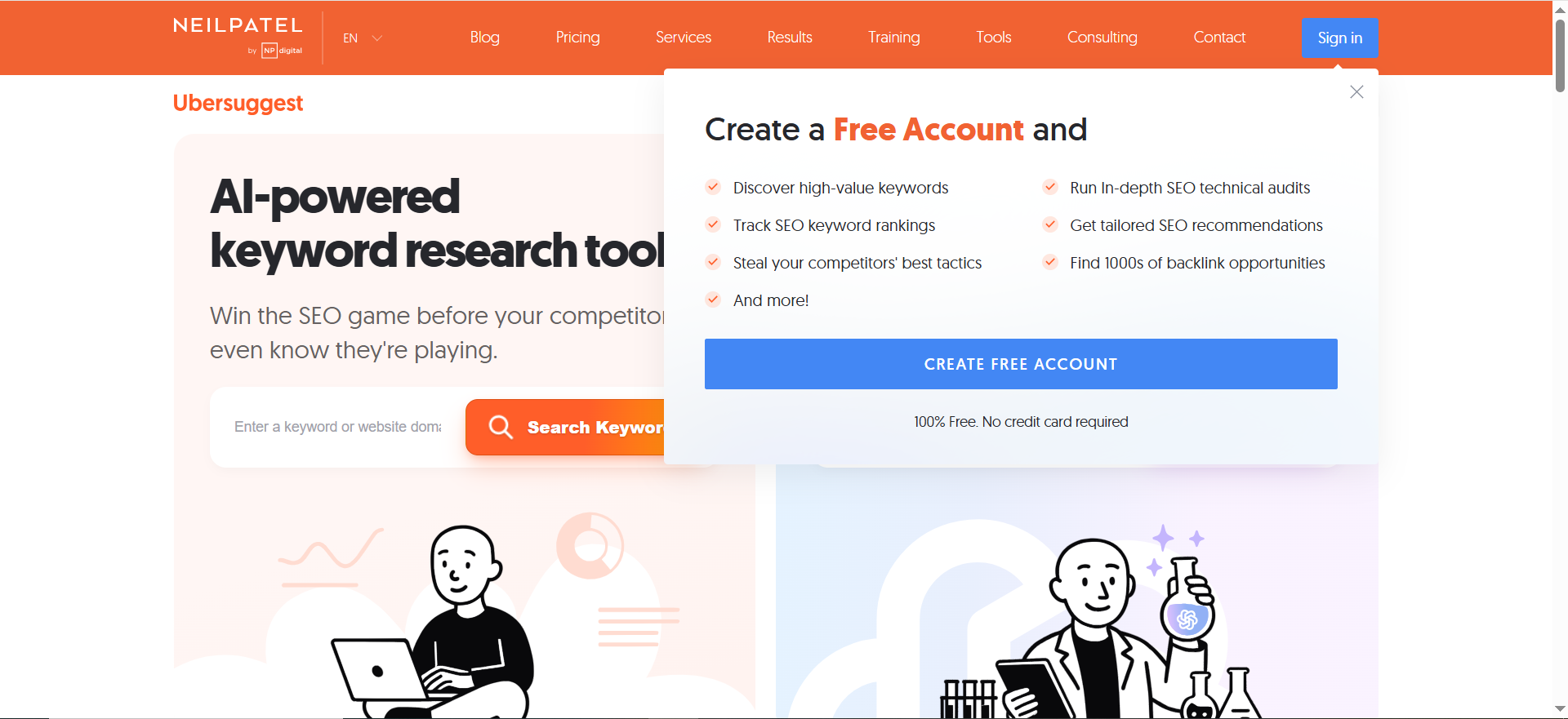
Entry-level pricing, simple keyword ideas, basic site audits, and rank tracking—good for getting started. It covers the basics well enough to validate topics and tidy up easy site issues.
▶️ Where it shines vs Ahrefs: The price and straightforward interface. You can jump in, get keyword ideas, and track a small set of terms in minutes.
Keep in mind: Lighter data depth and fewer advanced features. As traffic grows, you may want a fuller suite.Best for: Solo creators, early-stage websites, budget-first teams.
Try if you need: A starter tool to validate topics and fix basics.
First steps: Run Site Audit to fix easy issues, add 10–20 keywords to Rank Tracking, and use Keyword Ideas to outline your next 3 posts.
7. SpyFu — Best for Competitor & PPC Insights on a Budget
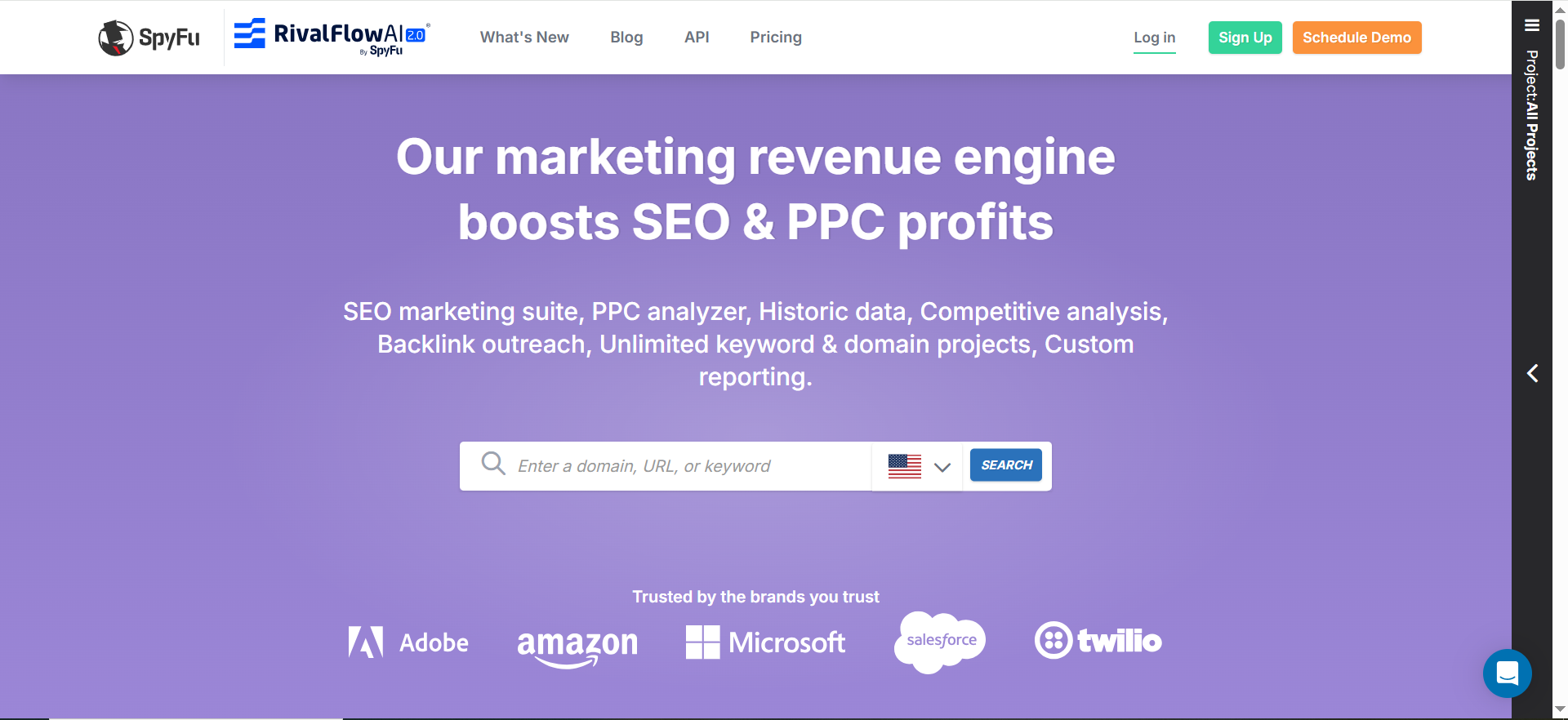
Excellent historical competitor data—see what rivals rank for, what they bid on, and how their ads evolved. It’s great for finding proven keywords and angles you can adapt.
▶️ Where it shines vs Ahrefs: PPC and competitor overlap visibility at a lower cost. You’ll quickly spot terms competitors invest in, signaling commercial value.
Keep in mind: Not a full technical SEO toolkit; pair with an auditor. Use it to guide content and PPC alignment, not site health.
Best for: Competitor recon, PPC-SEO alignment, content gap ideas.Try if you need: Affordable competitor intelligence.
First steps: Enter two competitors in Kombat to find overlapping keywords you’re missing, then export the list and build pages targeting those gaps.
8. Serpstat — Best Budget “All-in-One”
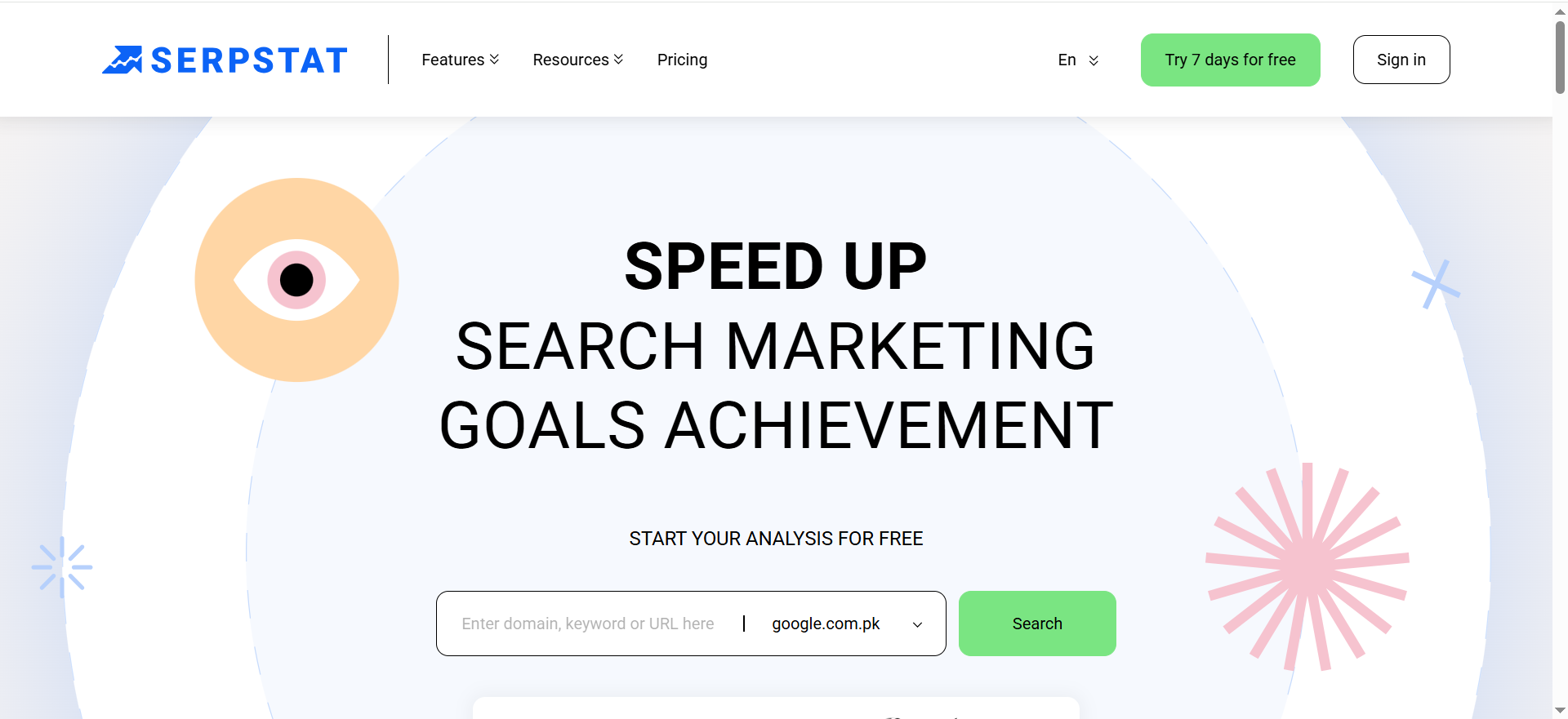
Broad coverage (keywords, auditing, rank tracking, backlinks) with team-friendly pricing. It’s a practical “good enough” suite when you want most features without premium costs.
▶️ Where it shines vs Ahrefs: Value per seat and enough features for most use cases. Handy for startups that need ranking, auditing, and basic link data in one place.
Keep in mind: Interface can feel dense; backlink data lighter than premium suites. Focus on the core modules you’ll use weekly.
Best for: Startups and price-sensitive agencies.
Try if you need: One platform that “does enough” to run campaigns.
First steps: Set up Rank Tracker, run a Site Audit, and use Tree View (site structure) to spot thin/duplicate pages to merge or expand.
9. Screaming Frog — Best for Technical Audits (One-Time License)
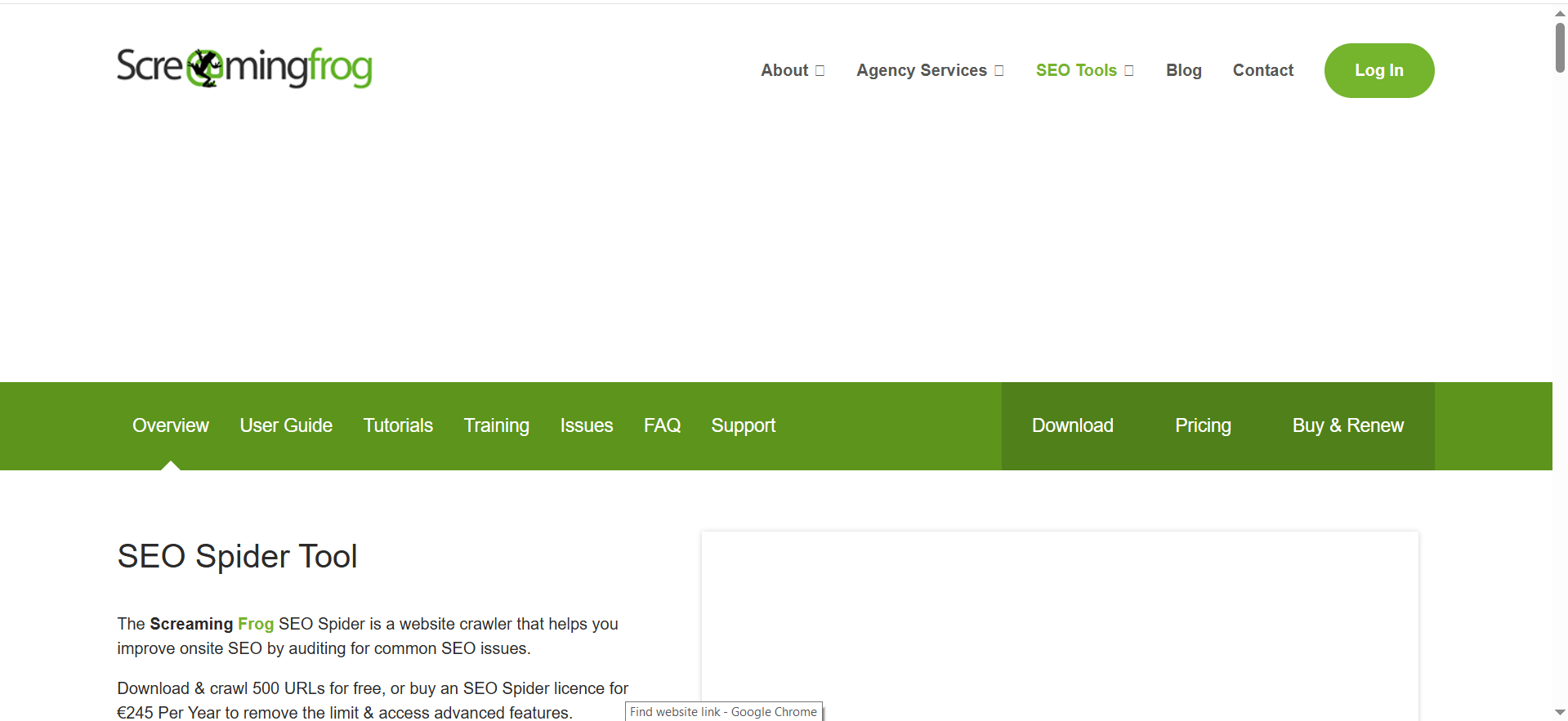
The gold-standard crawler for finding technical SEO issues (broken links, duplicate content, thin pages, hreflang, and more). It gives you precise, exportable lists so devs and editors know exactly what to fix.
▶️ Where it shines vs Ahrefs: Deeper, customizable crawling and export control. You can tailor crawls to your site’s quirks and get highly specific reports.
Keep in mind: Desktop app; not a keyword/backlink solution. Pair it with a suite for rankings and research.
Best for: Technical SEOs, developers, and teams fixing sites at scale.Try if you need: Serious technical clean-up and site health checks.
First steps: Crawl the site, then export Response Codes (4xx/5xx), Redirect Chains, and Duplicate Titles; fix these three buckets first for quick wins.
10. Free/Native Stack — Best for Zero-Budget Starts
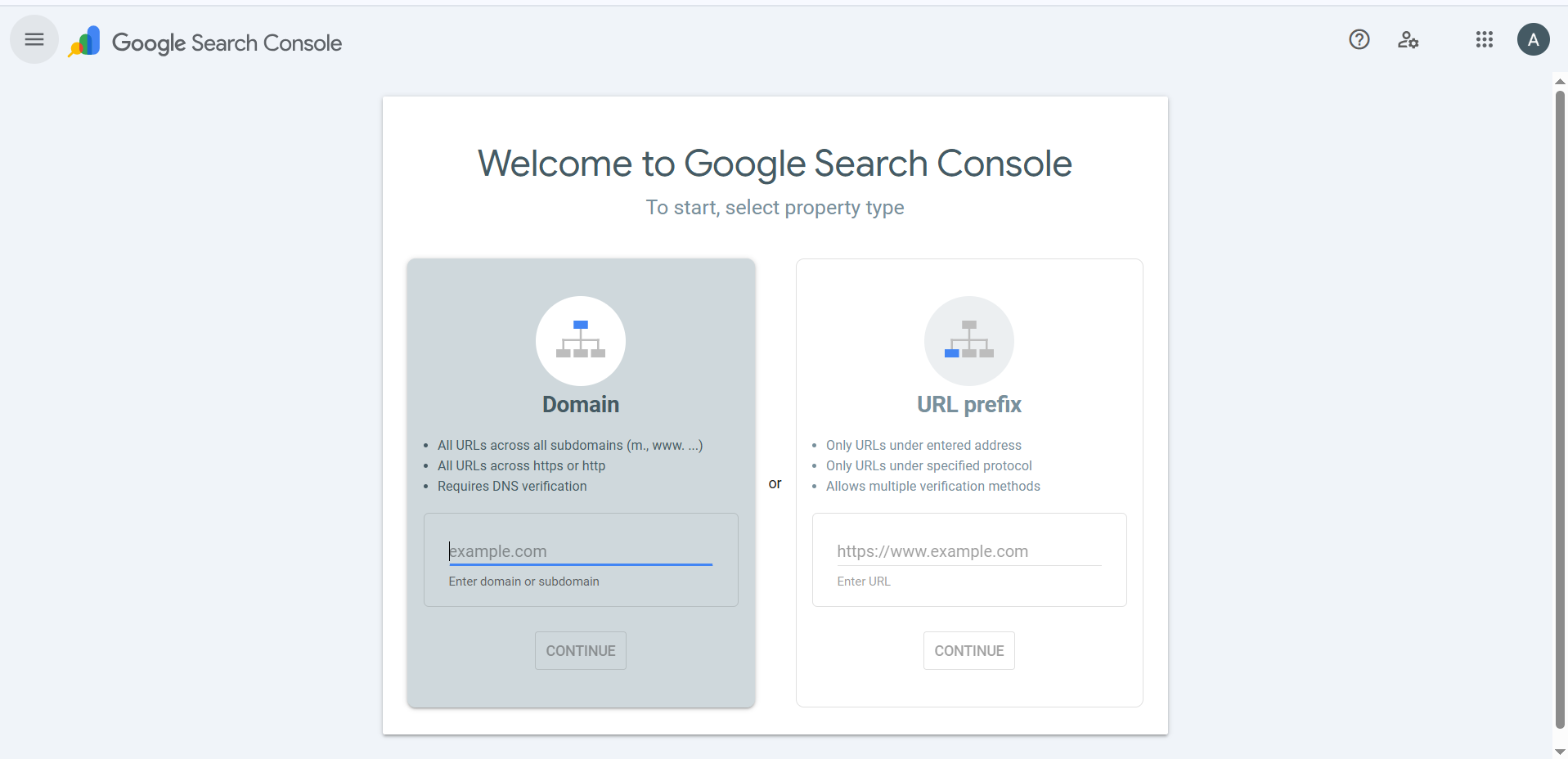
(Google Search Console, Google Analytics, Google Keyword Planner)
The most accurate first-party data on your site’s performance, free. GSC shows real queries and pages getting impressions; GA shows behavior; Planner helps expand topics.
Keep in mind: You’ll combine tools manually; no private backlink index. It’s enough to start publishing and improving, especially for new sites.
Best for: New sites, validation stages, and anyone learning SEO fundamentals.Try if you need: A no-cost way to prioritize pages and keywords.
First steps: In GSC, check Performance → Queries to find quick-win keywords (positions 8–20), improve those pages; use Planner to expand related topics.
Why Trust The Rank Masters?
- We run SEO for businesses in multiple niches, from local services to ecommerce.
- We prioritize clarity and ROI: fewer tools, more execution.
- Our recommendations come from hands-on use in real campaigns, not just feature lists.
▶️ Want help picking the right stack for your goals and budget? Book a free 30-minute strategy call and we’ll match the tool to your next 90 days of work.
How to Pick the Right Ahrefs Alternative in 5 Minutes (Step-by-Step)
Here are the 5 step method you should consider:
1) Start with your main goal
Are you prioritizing keyword research, backlinks, site audits, rank tracking, competitor intel, or local SEO? Pick the top 1–2 that matter in the next 90 days and ignore the rest for now. If keywords are central to your plan, follow best practices for SaaS keyword research to validate topics quickly.
Quick tip: Write one sentence: “Over the next 90 days, I need a tool that helps me [goal] so I can [business outcome].”
2) Match features to that goal
- Keywords: database size, clear difficulty scores, quick SERP snapshots (who ranks, intent).Good sign: You can save keyword lists and group by topic in one click.
- Backlinks: index coverage, freshness, and competitor link gap reports.Good sign: It surfaces link types (editorial, directories) and topical relevance.
- Audits: crawl depth, duplicate issues detection, and a simple, prioritized fixes list—use a B2B SaaS content audit checklist to structure fixes and compare tools against that workflow.
- Good sign: Error → why it matters → how to fix → where on your site (shortlist SaaS SEO audit software to cover technical gaps).
- Rank tracking: update frequency, locations (country/city), and device splits (desktop/mobile).
Good sign: Cannibalization or SERP feature tracking (e.g., featured snippets) see best SEO rank tracking tools for reliable options.
3) Be honest about budget & team size
Solo blogger, small team, in-house marketer, or agency? Start lean. You don’t need enterprise tools to publish better content and fix site basics.
Rule of thumb: If you won’t use a feature weekly, don’t pay for it yet. Upgrade when your workflow demands it.
Book a 30-min tool-matching consult →
4) Ease of use matters
A clean interface and simple reports beat massive toolsets you won’t touch.
Look for: saved views, labels/folders, one-click exports, and report templates your stakeholders can understand without a walk-through.
5) Data reliability & support
Prefer tools with regular updates, clear methodology docs, and responsive support (chat/email).
Quick checks:
- When was the last database update noted?
- Is there onboarding or a checklist for week one?
- Are tutorials and help docs easy to search?
▶️ Get a quick SEO audit recommendation
Switching From Ahrefs: A Practical, Low-Risk Migration Plan
1) Export essentials
Before you change tools, grab the data you’ll reference most. This lets you keep your best-performing keywords and pages visible, and it gives you a clean “before” to compare against later.
- Export: keywords, top pages, backlinks, rank history (CSV/Sheets).
- Keep any disavow file and notes/tags tied to important links.
- Name files clearly (e.g., site-keywords-2025-10-03.csv) so you can find them fast.
- Store in one folder you’ll reuse for the new tool’s imports.
2) Map features
List the Ahrefs reports you actually use and match them to equivalents in your new stack. This prevents “where did that go?” confusion and keeps your workflow intact. Pick your top 3–4 Ahrefs reports (the ones you open weekly). To speed selection, shortlist an ROI-first SEO tool stack for SaaS and map each report to a like-for-like module.
Pick your top 3–4 Ahrefs reports (the ones you open weekly).
- Common swaps:
- Site Audit → Screaming Frog / SE Ranking / Semrush
- Content/Keyword Gap → Semrush / Serpstat
- Backlink Gap / Compare → Majestic / Semrush
- Top Pages / Best by Links → Semrush Pages / Majestic Top Pages
👉 Make a 2-column checklist: “Ahrefs → New tool” and tick each once found.
👉 If a report doesn’t exist, note the closest alternative or a workaround.
3) Rebuild dashboards & alerts
Recreate the basics so you don’t miss changes. With ranks, audits, and alerts set, you’ll have day-to-day visibility without manual checks.
- Rank tracking: add brand + 10–20 core/money keywords (desktop + mobile, main country). Use SEO rank tracking for SaaS to pick a tracker that fits your cadence.
- Site audits: schedule weekly/biweekly; focus fixes on 4xx, redirect chains, noindex mistakes. If you’re choosing scanners, compare SaaS SEO audit software for crawl depth and export control.
- Alerts: enable email notifications for position drops, lost/gained links, and crawl errors.
- Reports: save an export template you can reuse each week/month.
4) Re-baseline
Create a fresh starting line inside the new tool. From here on, any movement reflects your new tracking and auditing, not old metrics.
- Run a full crawl and save the report as “Day 1 Audit.”
- Capture a rank snapshot and save as “Day 1 Rankings.”
- Note current top pages and quick-win keywords (positions ~8–20).
- Set a calendar reminder to compare Day 1 vs. Day 30.
If you need momentum in the first 30–45 days, our SaaS content audit & fix sprint can prioritize the highest-impact fixes fast.
5) Phase the transition
Avoid hard cutovers. Keep a brief overlap so you can cross-check a few key numbers and make sure nothing critical is missing.
- Keep Ahrefs for one billing cycle while the new tool runs in parallel.
- Spot-check: one audit report, one backlink comparison, one keyword set.
- If the new dashboards cover everything you rely on, deprecate Ahrefs.
- Document the new login, dashboards, and export routine for your team.
Frequently Asked Questions
Not really for everything Ahrefs does. But GSC + GA + Keyword Planner is a powerful free stack for early stages, and Screaming Frog’s free version crawls small sites.
Indexes change. Instead of chasing “biggest,” look at whether the tool surfaces the links you can actually use (competitor links, topical relevance, and quality). Ahrefs, Semrush, and Majestic are popular choices for deep link work.
If you need SEO + PPC + competitive research in one place, Semrush. For a lower cost with strong rank tracking and reporting, SE Ranking.
No. Many teams use a primary suite + one specialist (e.g., SE Ranking for day-to-day + Screaming Frog for technical crawls).
Final Thoughts: Choosing the Best SEO Tool for Your Next 90 Days
You don’t need the “perfect” Ahrefs clone, you need the right tool for what you’re doing next. If you want one platform that covers most bases (and adds PPC/competitor intel), Semrush is the safest all-around pick. If you want great value with clear reporting, SE Ranking is hard to beat. For beginner-friendly workflows, try Moz Pro or Ubersuggest. If backlinks are your world, add Majestic. For technical fixes, Screaming Frog is the fastest lever. And if you’re starting at zero budget, use GSC + GA + Keyword Planner to publish, measure, and improve.
The winning move is to focus on your next 90 days:
- Track 10–20 money keywords and run a site audit.
- Publish 3–4 pieces targeting low-difficulty, high-intent topics.
- Fix the highest-impact technical issues (404s, redirect chains, slow pages).
- Review competitor gaps and plan one new page per gap.
If your needs change, your stack can, too. Many teams run a primary suite + one specialist (e.g., SE Ranking + Screaming Frog or Semrush + Majestic). Start lean, prove ROI, then expand.
💡 Want a second opinion? We’ll help you match the tool to your goals, budget, and team size “no fluff, just a practical setup you can use this week”. Book a free 15-minute consult, explore our SEO Services, or browse Case Studies to see how we execute this in real campaigns.





